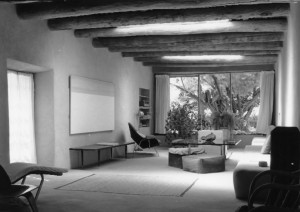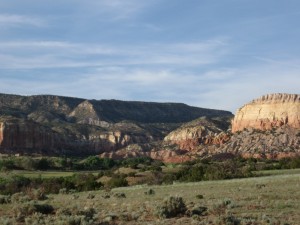I visited the Georgia O’Keeffe Museum for the second time in 2010, while I was in New Mexico shooting footage for a multimedia video piece relating to O’Keeffe’s New Mexico paintings. While filming the locations that formed the basis for many of her paintings, I sought to gain some insight into the sources of her inspiration. O’Keeffe paintings are somehow very musical in character, and I’ve wondered how, if at all, music had influenced her (even if indirectly). I knew that she had some personal interest in music, as is obvious from the titles of paintings such as Music, Pink and Blue No. 2, or Blue and Green Music. O’Keeffe herself had played the violin at an earlier point in life, and she considered singing to be “the most perfect means of expression”.
While in Santa Fe I met with museum curator and prominent O’Keeffe scholar Barbara Buhler Lynes, who was kind enough to point me towards some leads for research. I described the video project to her, and how my work is propelled by a musical response to O’Keeffe’s paintings ”“ the musical texture, timbre, and harmony that I imagine as the musical environment in which her visual world would exist.
Ms. Lynes directed me to the Georgia O’Keeffe Museum Research Center Library, where I read an essay on O’Keeffe and music by a former curator for the museum, Heather Hole, which was written for a program by the Santa Fe Chamber Music Festival. The library also had a complete log of the LPs that were found in O’Keeffe’s possession after she passed away in 1986. This essay, the list of musical recordings, and my later tour of O’Keeffe’s home in Abiquiu, helped to illuminate the role that music played in her life.
Ms. Lynes explained that O’Keeffe was influenced by the concept of synesthesia ”“ the experience of “crossed senses”, i.e. hearing images or seeing sounds ”“ as it had been explored by European modernists such as Wassily Kandinsky (1866-1944). These artists sought to find the equivalents of music in color and imagery, and to find a universal language in art that transcends the specificity of language or direct representation.
According to Heather Hole, O’Keeffe had been influenced by one of her teachers at Teachers College of Columbia University, Alon Bement, who had played music in his classroom and directed the students to “draw what they hear”. From early in her career, O’Keeffe appreciated the abstract quality of music because it seemed somehow essentialized or pure, and freed from the superficial details of representational art.

Once she had permanently settled in New Mexico in the late ’40s, O’Keeffe had a high-quality McIntosh stereo system installed in a peaceful and spacious room in her Abiquiu home. There she would lay in her favorite lounge chair, gazing beyond a wall-sized window at an elegantly framed salt cedar tree, and absorb recordings with full attention. She supported the Santa Fe Chamber Music Festival early on in its existence (during the latter decade or so of her life), and invited musicians to perform for her in her home, where she would listen to them, often with eyes closed. In Hole’s article, one of the musicians related how she would listen with a striking intensity of focus.
Her large library of LPs included primarily classical music. Interestingly, O’Keeffe didn’t seem to listen to very much music by then-contemporary composers. Perusing the catalog, I spotted just one or two records each of Stravinsky, Hindemith, Gershwin, and Ives, as well as an Edith Piaf album and some odds and ends.
Although she was friends with Aaron Copland, and owned a record that he conducted, she didn’t seem to be a fan of his music ”“ despite the fact that today’s listener would likely consider her landscape paintings “Coplandesque” in their evocation of American pastoral sensibility, or a classically American earthiness and simplicity of language.
Above all, O’Keeffe collected music of the 18th and 19th centuries ”“ Beethoven, Schumann, Haydn, Bach, etc, and surprisingly to me, a quantity of Monteverdi madrigals, sacred music and operas (including multiple recordings of the opera “The Coronation of Poppea”) ”“ which were relatively obscure at the time she was listening ”“ as well as Verdi and Wagner operas.
Although O’Keeffe is associated with the Modernist and Abstract movements in visual art, it seems natural that her musical tastes reflected the lush, lyrical, conventionally emotive quality of earlier music, rather than the harmonic and rhythmic explorations of the early-mid 20th century. The shapes in her paintings are rounded and flowing, the colors rich, and her paintings are often strikingly passionate and direct in their emotive quality ”“ yet always balanced, elegant, and poignant in simplicity, like a Classical sonata or Romantic Lied.

